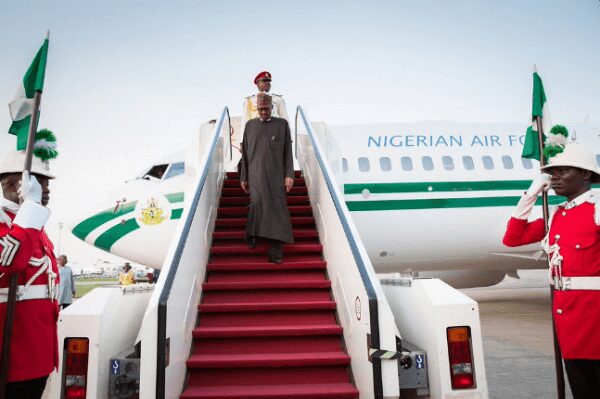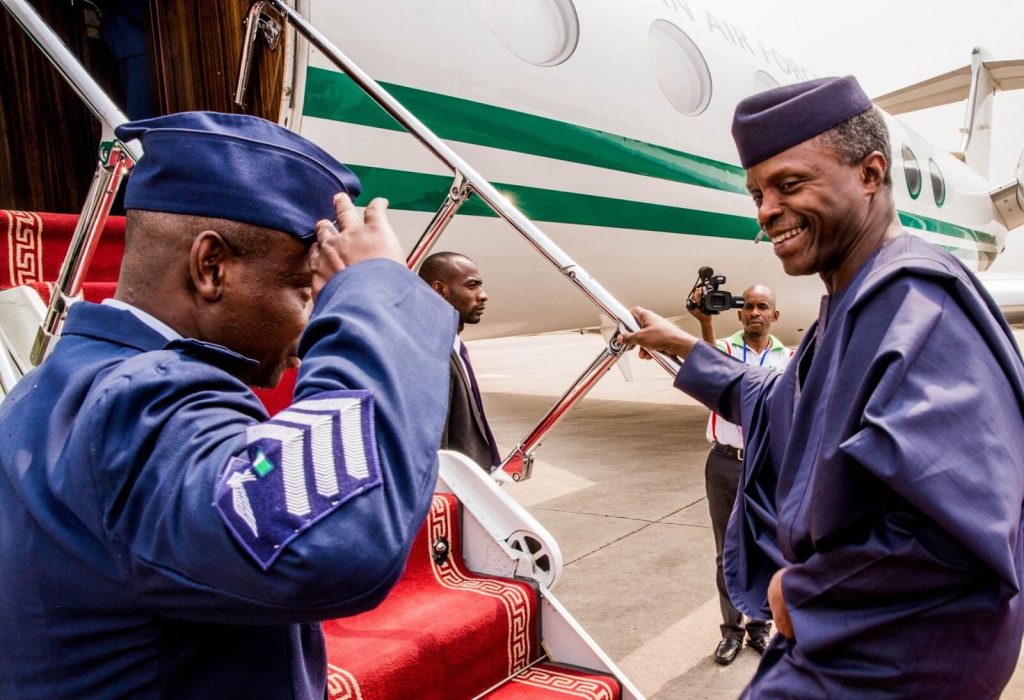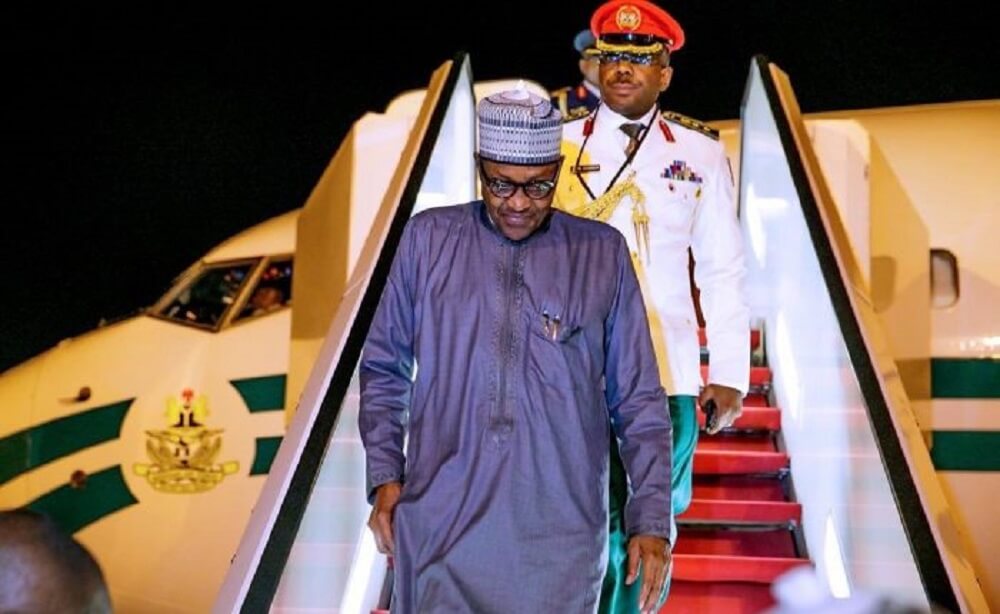How Buhari’s Administration Spent N61.2bn On Maintenance Of Presidential Jets
… Ten Presidential Jets Too Much For A Struggling Nation Like Nigeria—Experts
The administration of President Muhammadu Buhari allocated the sum of N61.21bn between 2015 and 2022 on maintenance of the Presidential Air Fleet, figures obtained from the Budget Office have revealed.
Advertisement
The amount was arrived at based on analysis of the annual budgetary allocation made by the federal government to the PAF.
The Presidential Air Fleet was formed to primarily provide rapid, safe and comfortable airlift for the President, the Vice President and other Very Important Person(s) as may be directed by the President through the Office of the Chief of Staff to the President.
As it is with any efficient organization, the PAF is well-structured and it has a Fleet Headquarters with five Wings, which are administration, operation services, supply, engineering and operations.
The Presidential fleet included 10 aircraft, namely one Boeing Business Jet (or Air Force One) 737, one Gulfstream G550, one Gulfstream G500, one Hawker 4000, two Falcon 7X, two AgustaWestland AW139 helicopters, and two AgustaWestland AW101 helicopters.
Advertisement
Buhari had during the 2015 presidential election campaigns promised to reduce waste in governance by downsizing the presidential fleet.
The President had promised to sell some of the aircraft in the fleet so as to minimize the cost of governance.
Maintenance Of PAF Rises By 140%
But seven years after the promise to reduce cost of the fleet was made by the President, the cost of maintaining the jets has assumed an upward trend rising by about 140 per cent within the seven-year period.
According to the budget document, the sum of N5.19bn was allocated to the Presidential Air Fleet in the 2015 fiscal period made up of capital expenditure of N1.5bn, overhead cost of N3.63bn and personnel cost of N40.2m.
Advertisement
The allocation in 2016 dropped to N3.6bn but rose to N4.37bn, N7.26bn and N7.29bn in the 2017, 2018 and 2019 fiscal periods.
Further analysis of the budget showed that it costs Nigerian tax payers even more to maintain the Presidential jets in 2020, 2021 and 2022 as the federal government allocated N8.51bn, N12.55bn and N12.45bn respectively.
A breakdown of the allocation showed that in 2020, capital expenditure gulped N4.1bn while personnel and overhead costs took N426m and N3.93bn respectively.
For 2021, about N8.17bn was allocated for capital expenditure while overhead and personnel costs gulped N3.93bn and N448m respectively.

In the 2022 fiscal period, analysis of the budget document showed that out of the total allocation of N12.42bn, the sum of N8.07bn was provided for capital, while overhead and personnel expenses had N3.93bn and N411.43m respectively.
Advertisement
A further analysis of the PAF’s budget showed that this year Buhari will spend N2.4bn on what the government referred to as “compliance with mandatory upgrades on PAF aircraft.”
The budget document also revealed that the government will spend N2bn on the overhaul of Gulf Stream G550, Falcon 7X and CL 605 engines.
Also, about N2bn will be spent on the repair of air navigational equipment. The budget of the PAF further revealed that purchase of aircraft calibration equipment will gulp N500m, while N210m was allocated for the “purchase of Phase 7 Avionics for AW 139 helicopters.”
Aviation fuel for PAF, according to the budget document, will gulp N250m. The sum of N1.6bn was allocated to general maintenance in the PAF budget while N1bn will be spent on the maintenance of aircraft.
Presidency’s Failed Attempt To Dispose Two Jets
The federal government has in 2016 attempted to sell two Presidential aircraft, a Falcon 7X executive jet and Hawker 4000, Both aircrafts were advertised for sale in October 2016, but the sale failed at the time.
It was learnt that the decision of the preferred bidders for the two jets to renege on their bid prices was largely responsible for the delay in the sales of the aircraft.

The Senior Special Assistant to the President on Media and Publicity, Garba Shehu, had said then that the bid amounts agreed to be paid by the two preferred bidders for the two aircraft stood at $24m, which was the projected sales figures.
However, he said the winners of the bids withdrew when they were asked to come and pay. The inability to sell the two jets made the government to return them to the fleet
“There are no serious buyers. It’s like those who showed interest initially wanted to rob the country of the aircraft. So, they (jets) have been returned (to the fleet),” he had explained then.
Why Its Expensive To Maintain Presidential Jets—Aviation Expert
An Aviation expert, Mr. Dayo Olusegun who spoke to THE WHISTLER blamed the rising maintenance cost of the Presidential Air Fleet on the declining value in the naira, the state of the aircrafts and the high cost of spare parts among others.
He also said that the high costs of aviation kerosene (Jet A1) fuel could be responsible for the high maintenance of the presidential fleet.
He said aside aviation kerosene (Jet A1) that is paid for in naira, virtually every other transaction regarding aircraft maintenance and operation is paid for in dollar.
Olusegun urged the government to sell some of the aircrafts in the fleet as the age of some of these aircraft may make them more expensive to maintain.
He said, “First and foremost, the Presidency doesn’t need 10 aircraft in its fleet. It’s too much for a struggling nation whose president should champion the crusade for cost cutting measures.
“Nonetheless, the principal reason for rise in cost of maintenance of aircraft generally is the depreciated and still depreciating naira. The naira keeps tumbling and this swells costs. How much was dollars in 2015 and how much is it now?
“Aside aviation kerosene (Jet A1) that is paid for in naira, virtually every other thing pertaining to aircraft maintenance and operation is heavily dollarised.
“Even the Jet A1 is expensive because it’s imported and not refined locally. The price has moved from over N100 in 2015 to about the current rate of N700/litre today.
“Unfortunately, Nigeria does not have a standard Maintenance Repair and Overhaul (MRO) facility for heavy mandatory checks like the C-Check. So, no dollar cut back by repairing these airplanes in-country.
“So, pilots are compelled to fly these aircraft overseas for maintenance and pay in dollars. They collect estacode for that assignment, adding to the cost of maintenance.”
He added that since the Presidential fleet is part of Nigeria’s national security architecture, they go to trusted overseas hangars for repairs at premium charges.
“Charges here can’t be haggled. They’re non-negotiable and this partly depletes the external reserves. Again, we can’t rule out graft. Corruption has permeated all facets of the economy
“So, there is a high possibility of swelling the repair costs to fatten individual accounts. Excess spares may be procured just for profiteering.”



